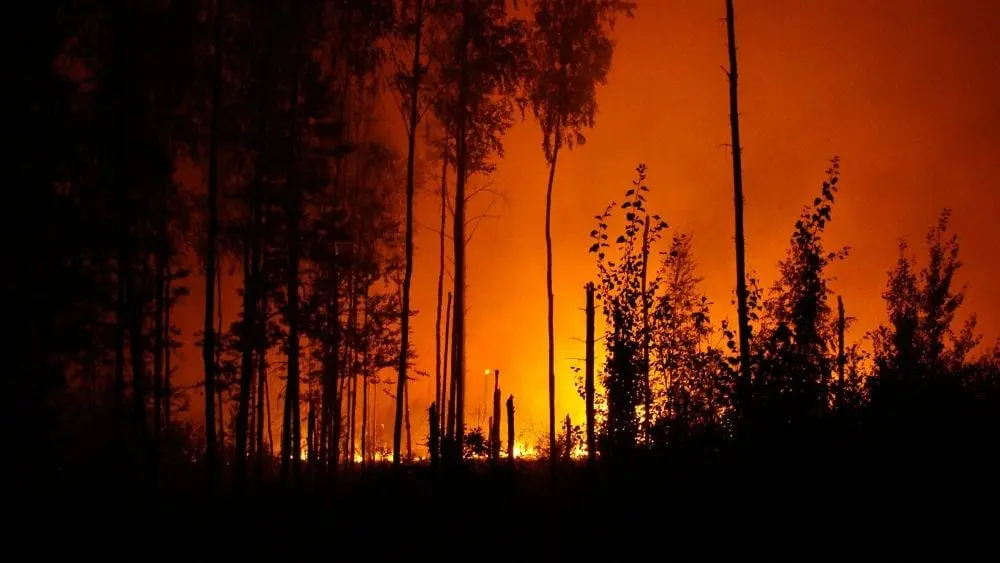
You’ve seen the headlines from around the
world: devastating wildfires engulfing entire communities in California, Brazil
and Australia. Wildfires are notoriously difficult to contain and can spread
feverishly, destroying wildlife, landscapes and neighborhoods, leaving homeowners
and insurance companies on the hook to pick up the pieces.
While California is the state most associated
with wildfires, 38 other states have areas at risk, according to the Insurance
Information Institute. This means every homeowner needs to take a sober second
look at their insurance coverage to ensure their home and possessions are
adequately protected should a wildfire or the subsequent smoke damage wreak havoc
on their property.
Here are seven things you need to know about
wildfires and home insurance coverage.
1. Your Standard Policy May Cover Your Home
Your standard homeowners insurance policy
should cover you for destruction and damage caused by fire, which includes
wildfires. But check your policy to make sure it covers fire and smoke damage —
with the proliferation of wildfire activity over the past few years, some
insurers have scaled back their coverage, or amended their policies, in
high-risk regions.
If your policy covers wildfire damage, it’ll
likely be broken down into two parts: dwelling coverage, also known as building
insurance, and personal property. Your dwelling coverage insures you for the
physical structure of your home, such as the floors, walls and ceilings, along
with attached structures like your garage. Should your home be damaged in a
wildfire, this policy will kick in, insuring you up to your policy limit.
You need to know if your dwelling coverage
insures your home at its replacement cost value, without factoring in its
market value or demand surge. Keep in mind, when you’re dealing with a domestic
house fire and your home is the only one that needs to be repaired, the cost of
labor and materials will likely stay within the parameters of your replacement
cost value. However, when an entire community of homes simultaneously goes up
in flames, those labor and materials costs can skyrocket. Your insurance
coverage likely doesn’t consider the cost of demand surge on homeowners, so you
would have to pay the difference out of pocket.
As for personal property, your home inventory,
from your furniture to your electronics and clothing, should be covered up to a
certain amount fixed in your policy limit.
Keeping a thorough and current inventory is
crucial. Take photos of each room to document your possessions and hang onto
digital copies of receipts, product model codes and manuals in the event that
you need to provide proof of loss in the aftermath of a wildfire.
2. You May Need Supplemental Insurance
You may need to pad your base home insurance
with extended policies for peace of mind.
This could include beefing up the amounts your
home and personal belongings are insured for to cover potential demand surge. In
addition, if you own valuables like jewelry, fine art or heirlooms that exceed your
coverage limit, you may want to take out additional coverage. Familiarize yourself
with your policy and talk with your insurance provider so there are no harsh
surprises. For example, some categories, such as watches and furs, may only be
covered for theft.
Picking yourself up from a wildfire comes with
another key policy extension: additional living expenses coverage. Where will
you live while you’re displaced and while your home is being repaired? Some
bare bones policies may provide accommodations for a week or two, but if you’re
worried about wildfires and the need to completely rebuild your home, this bit
of coverage could cover the cost of renting until it’s safe to move back into
your home.
Home insurance policies are highly specific so
don’t count on any other policies, such as earthquake or flood, to cover
wildfire damage. For instance, if an earthquake rattles your neighborhood and
triggers floods or fires that end up destroying your home, your earthquake
policy won’t cover any losses and damage caused by these subsequent events. For
this reason, you need to have all of your bases covered for whatever Mother
Nature may throw at you and your home.
3. California Faces an Urgent Wildfires Insurance Wake-Up Call
While homeowners in some states may have
straightforward policies that weave fire into their coverage, California is on
the opposite end of the spectrum. The insurance industry paid out $25 billion
in damage claims in 2017 and 2018 alone due to wildfires. As a result, insurers
have gradually retreated from providing wildfire insurance coverage by holding
back on writing new policies to outright canceling coverage and renewals even
to longstanding customers.
By December 2019, and for the first time in
California’s history, State Insurance Commissioner Ricardo Lara ordered a
one-year moratorium on insurance companies dropping customers in wildfire-prone
areas. This move barred all insurance companies from canceling existing
policies to some 800,000 homeowners in 16 regions that were ravaged by 2019
wildfires, according to the California Department of Insurance. It includes
portions of Sonoma County and Los Angeles.
Officials hope that the move will force
insurers and policymakers to figure out a solution to the state’s wildfire
insurance crisis as wildfires persistently destroy high-risk areas.
4. Other States Are at Risk Too
California isn’t an outlier here: Insurers
have been quietly cutting back on policies across the western United States, specifically
in Washington, Montana and Colorado.
In
Montana, the state’s deputy insurance commissioner issued a public notice in
August 2019 warning insurance companies against refusing coverage just because
of a wildfire elsewhere in the same ZIP code or county. In Washington and Colorado,
officials have also been grappling with complaints from homeowners about
insurance companies removing coverage in fire-prone areas. In both states, the
insurance commissioners have had to intervene and ask insurers to provide
concrete data on how many homeowners have been dropped and why they’ve scaled
back their coverage.
California tops the 2019 Verisk Wildfire Risk Analysis with over two million properties at risk, but it’s followed by Texas (717,800 properties at risk), Colorado (371,100 properties at risk) and Arizona (237,900 properties at risk). Idaho, Washington, Oklahoma, Oregon and Montana round out the list.
As fire season gets longer and more destructive each year, it’s estimated that by 2039, about 11 states could see a 500 percent increase in the amount of land that’s burned each year. Consulting firm Deloitte surveyed 27 state insurance regulators in 2019 only to find that just four states felt their insurers were “fully” or “largely” prepared to respond to the risks of climate change. The Deloitte report pointed to a growing debate about whether climate change — which is exacerbating natural disasters like wildfires — is making insurance too expensive for many people.
Striking the right balance has been difficult
for state insurance commissioners. They’re worried homeowners aren’t getting
the insurance coverage they need at a reasonable price, but there is a growing
concern that the insurance industry isn’t sustainable with the steady rise of
natural disasters.
5. Always Shop Around
For insurance to protect against wildfires, as
with any policy, it’s in your best interests to shop around and get a range of quotes.
Experts have noted that while insurers are being far more selective in the
types of homes they insure, it’s still an incredibly competitive market so it’s
worth comparison shopping.
In California, the state-sponsored Fair Access
to Insurance Requirements (FAIR) Plan is readily available to all residents and
is often the go-to for homeowners who haven’t secured home insurance against
wildfires. FAIR covers up to $1.5 million for a homeowner’s dwelling and
contents.
Insurance companies traditionally use
catastrophe models to calculate risks, such as hurricanes, flooding and
earthquakes. With flooding, for example, insurers will consider flood history,
rainfall, snowfall, topography and flood control measures. They’ll also look at
the age and state of your home — specifically if you’ve done your part to
protect it against flooding.
For wildfires, insurance companies used to
primarily rely on historical losses, but they’ve now shifted to using these
catastrophe risk models too.
California-based insurance companies use
Verisk Analytics’ FireLine system, which considers three more factors: fuel (the
grass, trees or brush that can feed a wildfire), slope (inclines that can
increase the speed and intensity of a wildfire) and access (whether homes are on
open roads and with driveway space to accommodate firefighting equipment).
7. How Your home Is Built Makes a Big Difference
The call to build fire-resistant homes has
only heightened in the wake of the most recent spate of destructive wildfires. While it’s impossible to build a completely fireproof
home, homeowners can take precautions to make their home as fire-resistant as
possible.
In November 2018,
California’s Camp Fire killed 85 people and caused $8.47 billion in insured
losses through nearly 30,000 auto, residential and commercial property
insurance claims, according to the California Department of Insurance. But the Insurance
Information Institute noted, in a white paper called “Fighting
Wildfires with Innovation,” that 51 percent of homes in the area built
according to the state’s updated building codes survived the fire, compared to
only 18 percent of homes constructed without the updated measures. The building codes recommended fire-resilient
construction, such as Class A fire-rated roofs, metal screens that cover all
vents and double or multipaned tempered glass windows.
Choosing materials like stucco, stone, brick,
interlocking tiles and concrete blocks over wood shingles or planks can make
your home more fire-resistant as well.
Even being strategic about your outdoor
landscaping can make a world of difference. Wood decks and fencing have a bad
reputation for fueling wildfires, while stone or other masonry can create a
fire-resistant barrier. Homes lined with mulch also fare far worse than homes
lined with rocks. Experts often recommend that homeowners create a five-foot
diameter of “non-combustible defensible space” using gravel, brick or concrete
in the area adjacent to the home. Don’t forget about installing outdoor
sprinkler systems to protect the sides and roof of your home.
Building or upgrading your home with
fire-resistant materials can lower your premiums substantially and, ultimately,
help safeguard your home against fire.

Carmen Chai is an award-winning Canadian journalist who has lived and reported from major cities such as Vancouver, Toronto, London and Paris. For NewHomeSource, Carmen covers a variety of topics, including insurance, mortgages, and more.
 Home Style Guide: The Timeless Cape Cod
Home Style Guide: The Timeless Cape Cod